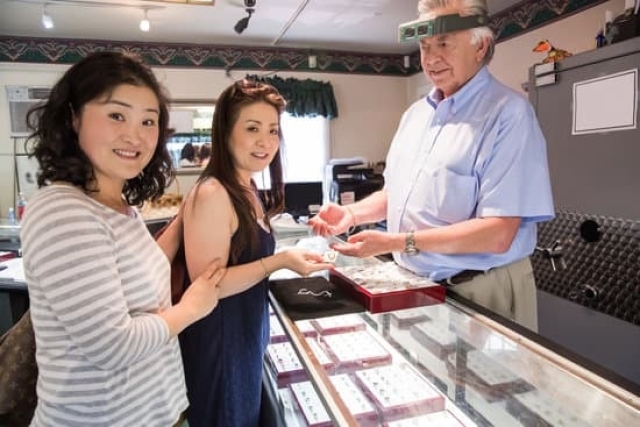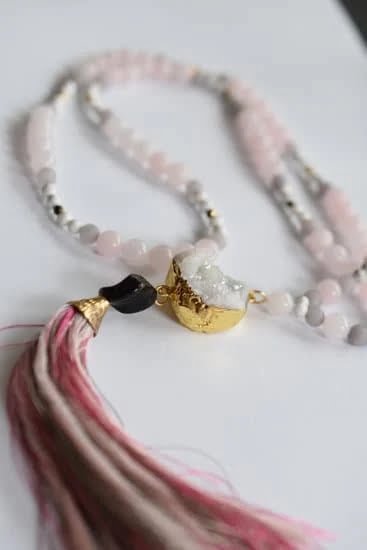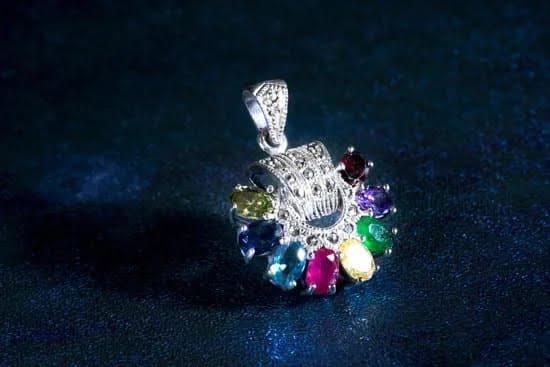Gold plated jewelry is a type of jewelry that is created by coating a base metal with a fine layer of gold. Typically, the base metal includes brass or nickel, which are commonly used because they are affordable and durable. Gold plating is not as long-lasting as solid gold jewelry since the gold plating can quickly wear off over time.
Therefore, it’s important to be able to identify gold-plated jewelry vs solid gold pieces. Identifying whether a piece of jewelry is gold-plated requires an examination under 10x magnification and/or physical testing with an acid test kit specifically designed for checking karat value of gold items.
Conclusion: Should You Put Gold Plated Jewelry in Jewelry Cleaner?
Although you may want to keep your gold-plated jewelry looking its best, it’s best to avoid putting it in any kind of jewelry cleaner since this could damage the coating of the metal resulting in discoloration or rusting. To clean your gold-plated pieces, you should use natural ingredients such as warm water and a mild soap like baby shampoo or dish soap.
Once washed and rinsed off, you can use a polishing cloth on both sides of the piece but be sure to avoid using abrasive cleaners as these may cause further damage to the item’s surface. After cleaning the dry piece with a lint-free cloth and allowing it some time to air dry before storing away for next use.
Advantages and Disadvantages of Gold Plated Jewelry
Gold plated jewelry is a cost-effective and attractive way to accessorize. It’s usually a much more affordable than solid gold jewelry and has the same beautiful color. If you have ever wondered if you can put gold plated jewelry in jewelry cleaner, the answer is yes and no. While some mild cleaners may not cause any damage, others should be avoided altogether.
One of the advantages of gold plated jewelry is that it won’t tarnish or discolor over time. Some forms of costume jewelry and silver pieces become dull after short use while gold-plated items are generally very low maintenance. The thin layers of gold created during production will remain intact as long as they aren’t exposed to harsh chemicals or frequent wear and tear.
The disadvantage of wearing gold plated jewelry is that the metal layer is much thinner than solid gold. As such, it can easily bend when exposed to too much pressure or stress and even begin to chip away or flake off with extended contact with water or cleaning products. This means that, if cleaned often with harsh solutions, gold plated pieces may require more upkeep or replacements than their solid counterparts.
When considering using a polish on your gold plated jewelry, it’s best to consult a professional jeweler for recommendations about products customers can safely use at home for cleaning purposes. Some polishes are specially designed for certain kinds of stones or metals but may be too abrasive for delicate pieces like those made from semi-precious materials or leather components then they may contain harsh chemicals which can strip away the thin layer of protective plating on your piece.
Be sure to read the label on the cleaner before putting your item in there so you don’t risk causing any permanent damage.
Identifying Gold Plating Quality
When it comes to gold plated jewelry, it can be difficult to determine if a piece can be safely placed in jewelry cleaner. The first step is determining the quality of the gold plating on your item as there are various levels of quality available. For example, items with higher karat ratings or heavier gauge platings tend to last longer than those who are lower in rating or lighter gauge.
It is also important to check other features on the piece such as variations in the color of the metal or any cracks, chips, or dents, which can indicate a weakened plating quality. In addition, more expensive gold-plated pieces are often found with a stamp indicating where and when they were made, which can help determine their origin and help you know what kind of care should be given when cleaning them.
Jewelry Cleaners Used For Gold Plated Pieces
For items deemed safe for cleaning with a regular cleaner; many prefer to use mild detergents diluted in warm water while having a soft brush nearby helps dislodge any dirt or crud from hard-to-reach places without scratching surfaces too harshly.
Items should also try their best not to get soaked and extra careful measure should take place if an ultrasonic cleaner is being used since this method works by using strong sound waves produced from submersed devices coming into contact with small amounts of solution and these waves may further wear down weaker platings over time.
Once finished cleaning gold plated pieces, it is best practice for owners not just to pat dry but instead have them air dried because lint from fabrics tends attach itself permanently onto surfaces otherwise without properly drying out between uses.
Impact of Jewelry Cleaner on Gold Plated Jewelry
Using jewelry cleaner with gold plated jewelry is a risky task. Gold plated jewelry has a thin layer of gold that has been applied over a base metal and the layer of gold can be easily corroded by certain chemicals. Jewelry cleaner will often contain acids and chemicals designed to clean regular metals which can destroy the delicate bond between gold and the base metal causing it to chip off in patches or completely fall apart if used repeatedly.
The best practice when cleaning something as delicate as gold plating is to dip the item in warm water with mild detergent, then scrub gently with a soft bristle brush. To remove tarnish, you can also polish it with toothpaste or a soft cloth.
If you are handling earrings or rings with stones, all of these methods will turn them cloudy, so avoid using them on gemstones. If they need extra shine, try using some rubbing alcohol diluted in water rather than running the risk of damaging the precious stones.
Finally, exposure to many household products can also damage gold plated jewelry such as chlorine found in pools, spa’s, and cosmetics like hairspray and perfume. So it’s best not to wear anything made from gold plated silver when exposing it to those kinds of chemicals Taking proper care of yourjewelry at homecan help preserve its condition for years to come allowing you longer lasting enjoyment from your beautiful items.
Types of Jewelry Cleaner and Possible Risks
Gold plated jewelry is a popular fashion trend, allowing people to enjoy the look of gold at an affordable price. Jewelry-wearers often wonder if they can use jewelry cleaner on their golden treasures.
First, it’s important to remember not all jewelry cleaners are the same. Ultrasonic and steam cleaning devices should be avoided when it comes to gold plated jewelry. These two methods can release the bond between gold-plating and the base metal, causing irreparable damage to the jewelry. It is not recommended that these methods be used on any type of gold plated pieces as they are too harsh.
Water-based or chemical-free cleaning solutions are much milder and an appropriate way of cleaning jewelry in this case. Although most cleaners marketed as universal can work on all types of metals, using something specifically formulated for gold is always a safer option; this includes both solid gold and plated pieces. As an added bonus they will clean out almost any dirt while not removing or affecting the beautiful color of the valuable metal beneath.
It’s also important to take into consideration potential risks associated with using any type of cleaner on jewelry items. It’s best to err on the safe side and use a solution diluted by half water so that it does not affect engravings, stones, or anything else attached to it in any way.
Also wearing rubber gloves during every cleaning session is strongly recommended for safety reasons in order to avoid possible skin irritation from any ingredients present in the solution used; many good quality cleaners list those ingredients clearly on their labels for users’ convenience.
Cleaning Gold Plated Jewelry At Home
Gold plated jewelry can easily become dirty due to exposure and contact with skin oils, creams, lotions, perfumes, and other elements. Regular cleaning is essential to maintain the original color and shine of gold plated jewelry. People often ask if they can put gold plated jewelry in jewelry cleaner. The answer to this question is yes: it’s safe to put gold plated jewelry into either a commercial or homemade cleaner solution.
To clean your gold plated jewelry at home, there are many simple solutions you can make from everyday items. For example, a mixture of warm water and a mild dish-washing soap works well for most metals.
You could also create a baking soda paste using one part baking soda to two parts of water which will act as an abrasive agent for tarnished pieces. Vinegar is another great cleaning solution for gold plated pieces; just leave the item in a 50/50 mix of vinegar and warm water for fifteen minutes before removing it from the solution with a soft brush or cloth.
If your pieces begin to look dull or discolored after attempting home cleaning solutions, professional cleaners may be necessary since some commercial chemical-based jewelers come equip with industrial processes that are more suitable for gold plating than your typical home remedy. It’s important that you select an experienced jeweler who specializes in cleaning items like yours so that they take extra care with delicate pieces.
Be sure to let them know ahead of time that the piece is spray-plated and has real gold on top vs solid yellow/white gold so that they use the appropriate chemicals during the process.
Cleaning Gold Plated Jewelry Professionally
More and more people are choosing to accessorize with jewelry made of gold plating – a thin layer of actual gold alloy over other metals. The best way to take care of your gold plated jewelry is to clean it professionally every six months, using a polishing cloth or professional jewelry cleaning services.
Professional cleaners who specialize in jewelry care understand the delicate balance between keeping the plating intact while also restoring its original luster. This can help extend the lifespan of your jewelry and ensure that it looks great for many seasons.
When selecting a professional service for your gold-plated jewelry, it is important to research different businesses and find one that is experienced in working with this type of material. A service should know exactly how to clean the piece safely and effectively without damaging the gold plating or any underlying components.
Professional services usually offer both ultrasonic cleaning machines, which use sound waves and mild cleansers, as well as chemical cleaning agents which break down built-up residue from exposure to air, oil, sweat and dirt.
It is not recommended that you attempt to clean gold plated items with those common DIY jewelry cleaners available in stores or online. These products are generally not formulated specifically for this purpose and can damage delicate pieces with their harsh chemicals or abrasive ingredients that may strip away the plating layer entirely. Additionally, these products often contain chlorine bleach which can discolor other precious metals like pearls or silver contained within an item of jewelry – better left alone.
The safest approach when dealing with gold-plated items is to only trust an experienced professional service when it comes time for a deep cleanse – so don’t try it at home. With reputable services such as TheJewelrySpot offering quick turnaround times at competitive rates, maintaining your bling could not be easier.
Strategies for Optimal Cleaning of Gold Plated Jewelry
Gold plated jewelry is a common choice for intricate and unique design pieces that look like the real thing for a fraction of the cost. While there are plenty of advantages to purchasing gold-plated jewelry, there are also some concerns, such as which cleaning methods will help keep them looking spotless. After all, it’s not solid gold and is subject to losing its luster if treated inappropriately.
There are of course other choices to polish your gold plated jewelry besides putting it in jewelry cleaner solutions, such as hydrogen peroxide or ammonia-based cleaners. However, these products can strip away the top layer of gold plating over time and damage delicate stones such as gemstones and opals. Additionally, immersing any other types of metals with varying levels of gold finish in traditional liquid jewelry cleaners can cause an uneven oxidation or discoloration on the metal surfaces.
An alternate solution would be to use a gentle soapy water cleanser instead. You can make this solution easily by mixing a mild dish soap with warm water until sudsy and then using a soft bristle brush if necessary to scrub off dirt and oils from your jewels without harming the surface coating or underlying layers.
Afterwards, you should rinse the pieces thoroughly before drying with a soft cotton cloth or paper towel. Doing this on a regular basis helps keep your jewelry sparkling by removing any build-up of residue over time.
If that doesn’t seem enough for you, there are also non-liquid solutions available for more thorough cleaning when needed such as silver polishing cloths or wipes specifically marketed for gold plated jewelry that have less abrasive ingredients than most liquid cleaners but still do an adequate job breaking up grease and dirt particles on their own.
If all else fails, it may be worth consulting with a professional jeweler who will know best how to make your accessory shine again without potential damage from any cleaning methods that don’t take into account its subtle differences from solid gold items.
Common Mistakes To Avoid When Cleaning Gold Plated Jewelry
Gold plated jewelry is an attractive and affordable option for many people. Despite the fact that it’s not as expensive as solid gold jewelry, gold plated jewelry still requires just as much attention and care when cleaning.
This means not to put gold-plated jewelry in the same chemicals or cleaners that are used to clean its pricier counterparts, like silver and gold. This article will discuss common mistakes to avoid when cleaning gold plated jewelry so you can keep your pieces looking their best.
The first mistake people make when cleaning gold-plated jewelry is being too abrasive. It is important to remember that although the surface layer of your piece is made up of real gold, it is only very thin and can easily be damaged or scratched if scrubbed too hard or with something too rough.
Therefore, when cleaning, it’s best to use either a soft cloth or brush specifically designed for delicate metals like gold plating rather than something like toothpaste which might cause scratches due to how harsh it can be.
Another common mistake made while trying to clean gold-plated jewelry is using improper chemicals or jewelry cleaners on them. Despite there being several types of machines used for fine jewelry cleaning, none of these should be used on gold-plated items since they won’t provide enough protection from damaging chemicals found in the solutions used inside these machines.
Anything acidic such as chlorine bleach should also be avoided since this could result in bleaching and discoloration of the item due its reaction with the metal underneath the outer layer of gold.
Finally, another common mistake made while attempting to clean gold-plated items is not taking proper care after each use. Cleaning needs to become part of a regular routine so tarnish does not build up over time and ruin its beautiful look over time due exposure from water, soap and other elements that may cause corrosion or rusting thus ruining its initial bright color finish.
Finally you should also store your items carefully so as even during storage they don’t get scratched or dented from rubbing against any hard surfaces such as wood or plastic boxes/ containers causes lessening of its luster over time.
Troubleshooting Best Practices for Gold Plated Jewelry Cleaning
When it comes to taking care of gold plated jewelry, the maintenance process is a bit more nuanced than your average piece of jewelry. Gold plating is a thin layer of gold applied to the surface of a base metal such as copper or silver.
This means that when you put your gold plated jewelry in a conventional jewelry cleaner, for example an ultrasonic cleaner, the result could be disastrous. The high-density waves from an ultrasonic cleaner could easily strip away the fine film of gold from your delicate pieces.
The best way to clean and preserve your gold plated jewelry pieces is give them a good wiping down with lukewarm water and gentle soap on a regular basis. Rinse them off and dry with a soft towel or cloth.
If you find that there is still dirt or grime stuck on parts of the jewellery that don’t come off with plain water, then use a very mild liquid dishwashing detergent diluted with warm water, and apply it directly onto the jewellery using an old toothbrush to work at the stubborn particles. Remember not too scrub too hard.
There are also some commercially available cleaning agents specifically designed for cleaning and maintaining gold plated jewellery safely, but make sure you read the label carefully before applying these products as they may contain harsh chemicals or abrasive particles that can cause damage if used incorrectly. Depending on how intricate or ornate your piece may be will determine which type of cleaning product would be best suited.
You may want to consider bringing it into the store from which you purchased it from so they can thoroughly cleanse your items keeping their shine and sparkle in tact.
Conclusion
The short answer to this question is no. You should not put gold plated jewelry in a jewelry cleaner as the machine will strip away the thin gold plating, leaving your piece of jewelry looking dull and worse for wear.
Gold plating is usually a very thin layer of metal applied to a cheaper base metal. It’s the process that gives imitation pieces their golden sheen, but it also means that it is highly susceptible to damages when exposed to harsh chemicals or certain conditions like extreme heat. A jewelry cleaning machine uses abrasive solutions and ultra-sonic waves which can erode away at the gold coating and leave behind only the underlying metal.
If you want to keep your gold plated jewelry looking shiny and luxurious for years to come, it’s best to opt for gentler methods instead. For example, you can create a non-abrasive DIY cleaner using warm soapy water, a soft cloth and an old toothbrush.
Simply dip your pieces into the soapy solution (not too hot) and swirl them around with the cloth or brush. After washing the items thoroughly in plain tap water, buff them until they look dry before properly storing them away from moisture and contaminants that might compromise their quality even more.

Welcome to my jewelry blog! My name is Sarah and I am the owner of this blog.
I love making jewelry and sharing my creations with others.
So whether you’re someone who loves wearing jewelry yourself or simply enjoys learning about it, be sure to check out my blog for insightful posts on everything related to this exciting topic!





